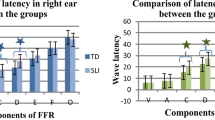Abstract
The results of analysis of auditory brain- stem evoked responses (ABRS) are reported in 173 patients with delayed speech (DS). The mean age of the patients is 4.6 years (age ranges from 1.4 years to 10 years). The patients were classified into 5 groups based on ABR findings:
-
Group I (62 patients) had normal hearing threshold and peak- interpeak latencies. The mean amplitude of wave I was however, not significantly low (p < 0.03).
-
Group II (27 patients) had an increased hearing threshold (40 dB), mild delay in the mean absolute peak latency of wave I (p < 0.03), decreased I– IV interval (p < 0.03), but highly significant reduction of wave I amplitude (p < 0.004). There is also a significant latency delay (p < 0.001) and amplitude reduction (p < 0.05), when this wave is compared with that a Group I (as control). These observations are suggestive of mild degree of peripheral hearing deficit in this group.
-
Group III (49 patients) had gross ABR abnormalities of various nature and hence may be sub- grouped into (a) SNHL cochlear type (55%) (b) SNHL retrocochlear type (4%) and (c) severed degree of SNHL undecisive group (41%). Ten patients (2.7%) among the sub- group (a) had unilateral hearing loss and another 3 had Down’s syndrome.
-
Group IV (conductive deafness) had an increased hearing threshold and shifting of ABR waves towards right with normal I– V interval. Only 6 patients were found in this group. It may be that conductive deafness is less important as a cause.
-
Group V (29 patients) had no responses at repeated ABR studies even at higher intensity of 95 dB, the ABR studies of this group correlates with the clinical evaluation of profound deafness. The delayed speech development in 84 patients (from Groups III, IV and V) may be caused by severe degree of hearing deficit as indicated by marked ABR abnormalities. If the mild peripheral hearing loss in Group II is added to the above groups, ABRs could identify 64.6% of our patients with hearing deficit. Hence, ABR test is most reliable and sensitive diagnostic test in detecting hearing loss, a common cause of delayed speech development in children.
Similar content being viewed by others
References
American Academy of Pediatrics, Joint Committee on Infant Hearing: Position Statement 1982. Pediatrics 1982,70: 496–7.
Bishop DVM. (1987): The concept of comprehension in language disorder. In : Martia JAM, Fletcher P, Grunwell P, Hall DMB, eds. Proceedings of the first international symposium on specific speech and language disorders in children. London : Association for all speech impaired children (AFASIC), 75–81.
Gerber SE, Jones BL, Costello MJ (1977): Behavioral measures in audiometry in infancy. New York, Grune and Stratton, 85.
Galambos CS and Galambos R. (1979): Brain-stem evoked response audiometry in newborn hearing screening. Arch. Otolaryngol105 : 86–90.
Hall D. (1988): Delayed speech in children. BMJ297 : 1281–2.
Ozdamar O, Kraus N, Stein L. (1983): Auditory brain-stem responses in infants recovering from meningitis : audiologic evaluation.Arch. Otolaryngol. 109 : 103–18.
Rutter M. (1987): Assessment of language disorder. In : Yule W., Rutter M., ed. Language development and disorders. (Clinics in developmental medicine 101/102). Oxford : Mackeith Press, Blackwell Scientific Publications,195 : 3–11.
Squires N, Aine C, Buchwald J, Norman R and Galbraith G. (1980): Abnormal functioning of the auditory brain-stem pathway in the Down’s syndrome. Electroencephalography & Clinical Neurophysiology.50 : 172–85.
Sohmer H and Student M. (1978): Auditory nerve and brain-stem evoked responses in normal austistic, minimal brain dysfunction and psychomotor retard children. Electroencephalogr & Clin Neurophysiol.44 : 380–8.
Author information
Authors and Affiliations
Rights and permissions
About this article
Cite this article
Husain, A., Kabiraj, M.M.U. Auditory brain stem evoked responses (ABRs) in children with delayed speech (DS)—A Diagnostic Problem. IJO & HNS 46, 83–87 (1994). https://doi.org/10.1007/BF03048877
Issue Date:
DOI: https://doi.org/10.1007/BF03048877




